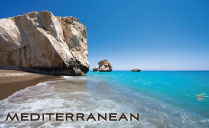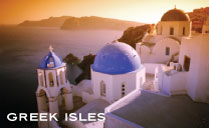Paradise Found by Captain John Borden
The Island of Dominica
15.34 N.Lat / 61.27 W.Lon
 In the wild grandeur of its towering mountains, some of which rise to five thousand feet above the sea; in majesty of its almost impenetrable forests, in the gorgeousness of its vegetation, the abruptness of its precipices, the calm of its lakes, the violence of its torrents, the sublimity of its waterfalls, Dominica stands without rival, not in the West Indies only, but I should think throughout the whole island catalogue of the Atlantic and Pacific combined.”
In the wild grandeur of its towering mountains, some of which rise to five thousand feet above the sea; in majesty of its almost impenetrable forests, in the gorgeousness of its vegetation, the abruptness of its precipices, the calm of its lakes, the violence of its torrents, the sublimity of its waterfalls, Dominica stands without rival, not in the West Indies only, but I should think throughout the whole island catalogue of the Atlantic and Pacific combined.”
 These were the words written by a European explorer in 1876 describing the central island of the Eastern Caribbean. While W. Palrgrave’s poetic attempt to capture the awesome power and beauty of the island comes close, there are simply no words which can possibly define her. This was a particular problem for the very first European explorer who, when asked to describe Dominica, fell utterly dumbfounded. In an audience with King Ferdinand and Queen Isabella of Spain, the resourceful and imaginative Christopher Columbus was reduced to crumbling a piece of paper to convey the stark imagery of the island’s landscape.
These were the words written by a European explorer in 1876 describing the central island of the Eastern Caribbean. While W. Palrgrave’s poetic attempt to capture the awesome power and beauty of the island comes close, there are simply no words which can possibly define her. This was a particular problem for the very first European explorer who, when asked to describe Dominica, fell utterly dumbfounded. In an audience with King Ferdinand and Queen Isabella of Spain, the resourceful and imaginative Christopher Columbus was reduced to crumbling a piece of paper to convey the stark imagery of the island’s landscape.
 Little has changed since, as Dominica has managed to remain as one of the last “untouched” islands in all the Caribbean. With the exception of a few modest roads and villages, she is as she has always been. Unlike most of the Caribbean islands, which boast gorgeous bays and sandy beaches. Dominica’s incomparable beauty lies primarily in her interior. This helps limit tourism to the more adventurous; those who are unafraid to set off on foot in search of hot spring waterfalls, boiling volcanic lakes, native parrots, monkeys and exotic vegetation.
Little has changed since, as Dominica has managed to remain as one of the last “untouched” islands in all the Caribbean. With the exception of a few modest roads and villages, she is as she has always been. Unlike most of the Caribbean islands, which boast gorgeous bays and sandy beaches. Dominica’s incomparable beauty lies primarily in her interior. This helps limit tourism to the more adventurous; those who are unafraid to set off on foot in search of hot spring waterfalls, boiling volcanic lakes, native parrots, monkeys and exotic vegetation.
There are a few commercial flights in and out of Dominica. The majority of island visitors arrive by private or charter boat, dropping anchor in Prince Rupert Bay at the northwest end and clearing customs in the quaint town of Portsmouth. Soon after you arrive you will be met by a flotilla of young local entrepreneurs offering to take you on a guided tour of the Indian River, for a nominal fee, of course. This excursion is well worth the seven or eight dollars; however, be sure to pick a rowing guide rather than one with an outboard who is more likely to disrupt the wildlife.
 The narrow, twisting river is quite magical, sheltered beneath a dense canopy of trees and vines. While the mouth of the Indian opens up into Prince Rupert Bay, I would not advise taking your own dinghy up river, for this act would be interpreted as a blatant attempt to sabotage a vital part of the island’s fragile economy. For the most part, Dominicans are a cheerful lot who aren’t over-exposed to tourists and are still quite helpful. The farther you get from the main settlements, however, the less likely you will be able to decipher the islander’s thick patois accents.
The narrow, twisting river is quite magical, sheltered beneath a dense canopy of trees and vines. While the mouth of the Indian opens up into Prince Rupert Bay, I would not advise taking your own dinghy up river, for this act would be interpreted as a blatant attempt to sabotage a vital part of the island’s fragile economy. For the most part, Dominicans are a cheerful lot who aren’t over-exposed to tourists and are still quite helpful. The farther you get from the main settlements, however, the less likely you will be able to decipher the islander’s thick patois accents.
At Prince Rupert’s north peninsula lies the Cabrits, two small mountains which served nicely as lookout points for the British in the 18th century. There is a well-marked trail on the eastern slope with a fantastic view from the top. The Dominicans have begun restoration of Fort Shirley at the foot of the Cabrits guarding the entrance to the bay. The completed sections and a small historical museum located at the fort are well worth seeing.
 As was the case with my wife Carole and me, it won’t be long before you’ll want to get a look at some of the island’s breathtaking hinterland. The Dominican National Park Service is well aware of the island’s natural merit and has done a marvelous job of providing a network of roads and hiking trails without spoiling the landscape. While one could spend days exploring the northern forest trails of this twenty-mile island, I would suggest heading south to the village of Roseau which borders Morne Trois National Park. Dropping the hook off the south end of the township or tying up at the Anchorage Hotel gives you easy access by foot. Dive Dominica is located next to the hotel and, if you are inclined to explore the watery side of the island, you will not be disappointed.
As was the case with my wife Carole and me, it won’t be long before you’ll want to get a look at some of the island’s breathtaking hinterland. The Dominican National Park Service is well aware of the island’s natural merit and has done a marvelous job of providing a network of roads and hiking trails without spoiling the landscape. While one could spend days exploring the northern forest trails of this twenty-mile island, I would suggest heading south to the village of Roseau which borders Morne Trois National Park. Dropping the hook off the south end of the township or tying up at the Anchorage Hotel gives you easy access by foot. Dive Dominica is located next to the hotel and, if you are inclined to explore the watery side of the island, you will not be disappointed.
Roseau itself has much to offer the discerning local craft hunters who will be amazed with the variety of bags, bowls, baskets and batik. The streets of Roseau are quite narrow and at times you’ll be holding your breath if you choose to rent a car. Passing a large truck on some stretches of roads is absolutely impossible, as I found out a bit too late, once bottoming out with both left wheels in the gutter. This is obviously a common occurrence, for no sooner had we gotten into this predicament than several large spectators has us back on our way without even having to get out of the car. On the outskirts of town you’ll find the Botanical Gardens and Forestry Division headquarters. From here you can join a park tour or inquire for directions to set out on your own.
Trafalga Falls is a must see. If you have ever imagined the ultimate tropical waterfall, Trafalga will surpass all of your expectations. Fed not only by mountain streams, but also by a natural hot spring, bathing in the water at the base of the falls is both relaxing and exhilarating. On one side, swirling Jacuzzi-like pools of hot mineral water will soak through to your soul. On the other side, a cool rushing shower excites every pore. You can spend hours going back and forth.
 Hiking further into the national park rain forest requires a guide, particularly if you wish to see the second largest boiling lake in the entire world. Situated in a volcanic crater one hundred and fifty feet across, this spectacle is an eerie sight to behold as horrendous volcanic pressure forces steam to groan from the very bowels of the earth, while enormous shoots of clouds burst from the bubbling froth and rise high up into the air.
Hiking further into the national park rain forest requires a guide, particularly if you wish to see the second largest boiling lake in the entire world. Situated in a volcanic crater one hundred and fifty feet across, this spectacle is an eerie sight to behold as horrendous volcanic pressure forces steam to groan from the very bowels of the earth, while enormous shoots of clouds burst from the bubbling froth and rise high up into the air.
There are many more falls, lakes, rivers and overlooks to visit, each just as spectacular as the next. It is no small wonder that Dominica is home to the last settlement of Carib Indians. Now reduced to farmers and craftsmen, the once-fierce race of warriors had ruled the Caribbean for centuries before European settlers intervened. The spirit of these proud natives is still captured in their artwork, especially the haunting war masks displayed in small galleries throughout the reservation.
There is simply no way to describe the sheer beauty and mystique of Dominica given volumes of text, much less these few short paragraphs. My advice is that if you are fortunate enough to sail along her inviting shore, I implore you, for goodness sake, don’t be content with just a visit to the beach bar.





